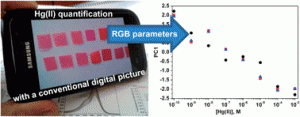Mercury is highly toxic, and contamination of drinking water by Hg(II) can cause serious damage to the brain and kidneys.
José M. García and colleagues at the University of Burgos have developed a simple method for detecting mercury in aqueous solutions. They report the synthesis of a polymeric “sensory membrane” containing a dye compound based on rhodamine. When dipped in water, this membrane produces a colour change relative to the concentration of mercury, thus allowing detection and quantitation by the naked eye. Furthermore, a photograph of the coloured membrane taken using the camera on a standard smartphone produces RGB parameters that can accurately quantify the amount of mercury present in tap water with an excellent limit of detection.
To know more about this research, take a look at the original paper. It will be free for the next 6 weeks.
Sub-ppm quantification of Hg(II) in aqueous media using both the naked eye and digital information from pictures of a colorimetric sensory polymer membrane taken with the digital camera of a conventional mobile phone
Hamid El Kaoutit, Pedro Estévez, Félix C. García, Felipe Serna and José M. García
Anal. Methods, 2013, 5, 54-58
DOI: 10.1039/C2AY26307F











